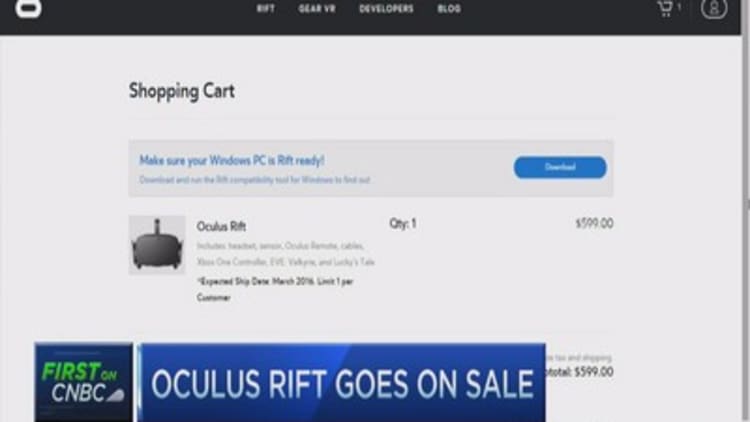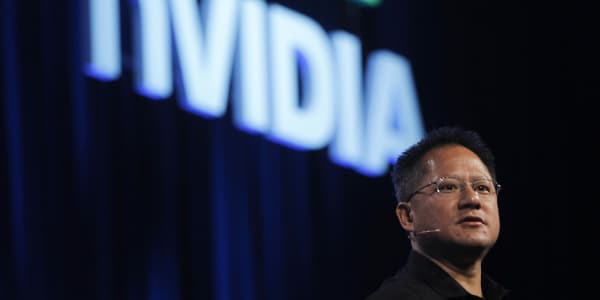
As I slid on the new HTC Vive Pre headset, the all-encompassing commotion that is Las Vegas during CES — the world's biggest annual consumer electronics show — faded away. For the first time in several days, I have escaped.
I'm at the bottom of a calm blue ocean on a sunken ship. I can reach out and gently flip away the little fish surrounding me. Look up, and see a giant whale gliding by. Look down, and I am drawn to the seamlessly never-ending blueness just past the edge of my ship. It's a long way down to the bottom of the ocean.
I'm a scuba diver, and this virtual world is extremely convincing, immersive and lifelike, I could get lost down there for hours. Except I can't — booth demos are booked back-to-back throughout the show.
That is the promise of virtual reality, which has come leaps and bounds since the first prototypes were released a few years ago. The HTC Vive Pre headset now has a front-facing camera which creates virtual walls around the user, warning them when they are close to the edge of the play space. The idea is to give users the confidence to walk around and explore while staying safe. (The specs for the new Vive Pre can be found here.)
That said, VR still has a way to go before it's an accessible — and comfortable — experience for the average consumer. Motion sickness is a problem for many users — and then there's the price tag. HTC has not yet released pricing for its new Vive headset, which will be commercially available in April — but it's likely to be at least as expensive as Facebook's Oculus Rift

Facebook opened up preorders for the Rift on Wednesday and it costs $599 per headset. That is slightly above analyst expectations, and that's with Facebook subsidizing the headsets to ignite the market. Despite this high price point and the need for a high-end PC — which start around $1,000 — to run the software, demand on the first day of presales was enough to overwhelm the Oculus website.
"You have to see it to really believe it and we feel like once you see it, you are going to want it," Oculus CEO Brendan Iribe told CNBC. When paired with the right VR experiences, motion sickness should not be an issue, he said.
Read More Oculus CEO: Working on pre-order issues, will be OK soon
Analysts agreed that Oculus is off to a strong start and are forecasting sales in the low single-digit millions but note that, as with all hardware, content will be key.
"We have yet to see the first killer piece of content to drive mass market adoption of the platform," said Piper Jaffray analyst Gene Munster.
The industry understands this and is investing in content. This year, Oculus will have 20 games coming from Oculus Studios — games the company funded to produce along with developers. There will also be more than 100 titles coming from independent developers. Oculus Story studio — an in-house team at Oculus — is also producing VR movies for the Rift: "Henry," a Pixar-like short film about a hedgehog, will be available later this year with more experiences in the pipeline.
On Wednesday, Qualcomm announced a new partnership with NextVR, a leader in live-action virtual reality broadcast technology, to bring 360-degree virtual reality content to any mobile device with the latest chip, the Qualcomm Snapdragon 820 processor.
"All of the technology for delivering the VR experience is now built into the phone," said NextVR co-founder David Cole. "Everything we can do, we can do live."
Cole cited NextVR's relationships with live broadcasters as a key competitive advantage, though he would not reveal which ones are on board. That said, the company recently broadcast the NBA season opener game and ring ceremony nationwide and the CNN Democratic debate to 121 different countries.
Thursday at CES, NextVR is broadcasting the Chicago Bulls versus Boston Celtics NBA game live in virtual reality. What does that look like? A bunch of people sitting in a whiskey lounge on the third floor of the Las Vegas Cosmopolitan hotel wearing headsets, which will transport them courtside.
"It's the best seat in the house that they are going to get transported to," said Cole.
Slipping on the NextVR headset myself, I was immediately whisked away from the noisy, crowded Qualcomm booth on the show floor to a serene natural lakeside setting, then I am in the middle of Times Square watching tourists take selfies as the traffic whizzes around me and neon signs flash up above. Next up it's sports, and this is likely the closest I will ever get to courtside for an NBA basketball game and field-level at a Manchester United versus Barcelona soccer match. The view is 360 and feels totally immersive.
"The exciting and sad thing about VR is that you don't even need to go anywhere — why bust your back going to see the great pyramids when you can see it on your couch?" said Munster.
Because it's mobile, I'm not tethered to anything, and I am certainly not about to start blindly wandering around. Mobile is the next phase of VR, and augmented reality, also known as mixed reality, is the third phase, said Munster.
Leap Motion is taking aim at both virtual and mixed reality. The company is here at CES showing off its latest innovations and meeting with potential partners. It is tackling one very specific — very complex — problem that is recreating the natural dexterity of a user's hands.
"The holy grail in VR is the sense of presence. If you can't see and use your hands it feels very shallow," said Michael Buckwald, co-founder and CEO of Leap Motion. "What's most important for VR and AR is that anything you can see you can reach out and grab."
Indeed the demo, which includes plucking petals from a flower, is impressive. The user's virtual hands look and act a lot like real hands, displaying a high level of dexterity. Importantly, there's is just a 4 millisecond delay between doing something and seeing it happen.
"No other technology can actually do that and that's very important to feel real," said Buckwald.
The company licenses its proprietary software and the necessary camera hardware specs for a fee. Buckwald would not reveal any details around partnerships or pricing, but said that the fee decreases as the volume increases. Though clearly a potential acquisition target, the company plans to remain independent for now, said Buckwald.
Munster highlighted Magic Leap, another company taking aim at augmented reality and a likely acquisition target for a giant like Microsoft, Apple, Sony or Samsung.
"They are basically using holograms that are projected onto your eyes," he said. Munster believes the way Magic Leap is approaching the interface sets the company apart from its competitors, but means it will take a lot longer to develop.
According to Crunchbase, the company closed a $542 million Series B funding in October. The lead investor was Google and the investor names are A list, including Andreessen Horowitz, Kleiner Perkins Caufield & Byers, Obvious Ventures and Qualcomm Ventures. Before that funding round, the company was valued at $1.5 billion.
There is still a way to go before VR and AR find their way into most people's everyday lives, but the innovations on show at CES certainly provide a window into this exciting new dimension.
Munster estimates that the VR headset market will grow to $62 billion in 2025 and sees a market for live sporting events, concerts, education, adult content, social experiences, movies and gaming reaching $5.4 billion in that same time frame. Piper Jaffray likens the state of VR and AR today to the state of mobile phones 15 years ago.
"We believe virtual reality and augmented reality are the next mega tech themes through 2030," said Munster. "Our optimism around the theme is based on consumers' insatiable appetite for new tech experiences: virtual and augmented reality are radically new tech experiences."
Munster believes Facebook, Google and Apple as the likely public company winners when it comes to VR and AR. It's still the Wild West on the private side, though some, including Magic Leap, Next VR, Jaunt VR, Leap Motion, OTOY, Matterport, Linden Lab and Valve are better-positioned, he said.
There are of course some risks: competition and convincing consumers that the value is great enough to sport those clunky headsets.






